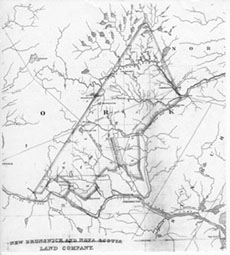

Elliott, Bruce, 2004-2005: Emigrant Recruitment by the New Brunswick Land
Company: The Pioneer Settlers of Stanley and Harvey.******************************************************************************** Introduction
The 1830s and 1840s were the heyday of the great land companies throughout much of British North America. The Canada Company in Upper Canada (Ontario), was founded in 1824 (and chartered 1826), the New Brunswick and Nova Scotia Land Company in New Brunswick in 1831 (chartered 1834), and the British American Land Company in the Eastern Townships of Lower Canada (Quebec) in 1832 (chartered 1834). (1) The land company was, from a governmental perspective, an early form of privatization, or more accurately to the period, a delegation of responsibility for land settlement (like the early leader and associates system, or the district land boards system in Upper Canada).
All these companies purchased large tracts of land at comparative bargain prices, promising to develop the settlement infrastructure of roads, mills, and towns, and intending to derive profits for their prominent English shareholders by reselling the lands to settlers. The attraction for the colonial governments was that the companies provided a large infusion of capital relatively quickly to executives and administrations that were locked in combat with their elected assemblies over the control of other forms of colonial revenue.
Map no. 1 New Brunswick & Nova Scotia Land Company Tract, 1834. The Company's Stanley settlement was immediately north of the pre-existing Welsh settlement at Cardigan.
Source : Private collection; see CIHM N.21463
Medium sized pop up image
700 X 776, 72 dpi 192 k
Full sized pop up image
2862 X 3173, 400 dpi 3036 k
The New Brunswick Company, as it quickly became known, was organized in 1831 and incorporated in 1834. It purchased a tract of 589,000 acres in York County north of Fredericton at 2s 3d per acre. The tract comprised all the lands in the county north of the Saint John and west of the Nashwaak, and west also of the portage road to the South West Miramichi (now Highway 8), apart from lands already ceded.
The promoters were inspired by what they saw as the "success of the Canada Company, and the extraordinary increase of emigration to America during the last five years." The Canada Company had sold 184,000 acres of land in Upper Canada in three years,(2) but the New Brunswick Company's directors did not take into account that most of this was former Crown reserves scattered, every seventh lot, through the old settlements. The Canada Company was not nearly as successful in drawing settlers to its million-acre Huron Tract, well beyond the current frontier of settlement, until natural inward expansion reached the frontiers of their holding at the end of the 1830s (3). The Huron Tract included much prime quality land, however, and it became attractive as the frontier of settlement pushed inexorably northward. The BALC in Lower Canada similarly reaped profits from selling reserve lots in the older townships, but was unable to counter the disadvantageous land quality and isolation of its rugged St Francis Tract, which in the end it exploited as timberland(4).
______________________________________________________
Bruce S. Elliott is a Professor of History at Carleton University in Ottawa, and Director of the Carleton Centre for the History of Migration. He wishes to thank Jocelean Swan Hall, Eric Herbert, Tony Brown, Tim Patterson, Linda Bankier of the Berwick-upon-Tweed Record Office, and Hamish Dunn of Wooler, Northumberland for their assistance. As in any project concerning the residents of nineteenth-century New Brunswick, Daniel Johnson's published abstracts of newspaper birth, marriage, and death notices were essential references, but they are not individually footnoted here.
Notes
(1) Anatole Browde, "Settling the Canadian Colonies: A Comparison of Two Nineteenth-Century Land Companies", Business History Review 76 (Summer 2002): 299-335 (re Canada Company and BALC); Miramichi Gleaner , 23 October 1831.
(2) Report of the Directors of the New Brunswick and Nova Scotia Land Company (London: Arthur Taylor, 1832), Canadian Institute for Historic Microreproductions (CIHM) fiche N.63916, pp. 8, 11.
(3) Clarence Karr, The Canada Company (Ottawa: Ontario Historical Society, 1974), 51, 102.
(4) J.I. Little, "Feast or Famine: The British American Land Company and the Colonization of the St Francis Tract", in his Nationalism, Capitalism, and Colonization in Nineteenth-Century Quebec: The Upper St Francis District (Kingston & Montreal: McGill-Queen's University Press, 1989), 36-63.
